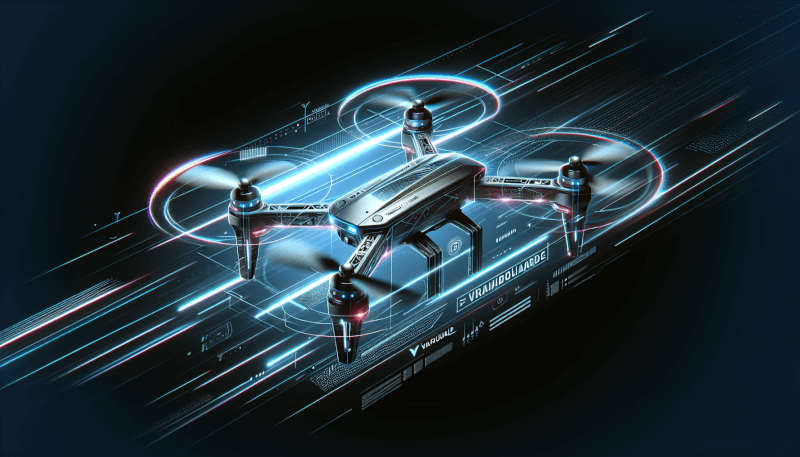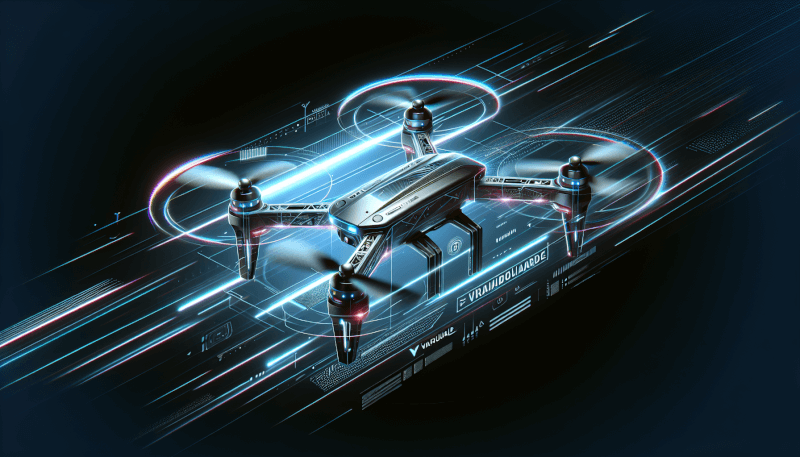Imagine soaring through the skies, embracing the breathtaking view from above, and capturing moments that were once only reserved for birds. Over the past year, the world of drones has experienced remarkable advancements, revolutionizing the way we see and interact with the world around us. From enhanced camera capabilities to increased flight time, the top drone technology innovations of the past year have opened up a world of possibilities, allowing us to explore and capture moments like never before. So buckle up and get ready to be amazed by the incredible technological feats that have taken flight in the drone industry.

1. Improved Flight Performance
Drones have seen significant advancements in their flight performance over the past year, making them more capable and efficient than ever before.
1.1. Longer Battery Life
One of the key improvements in drone technology has been in the area of battery life. Drones now feature longer-lasting batteries that allow for extended flight times. This means that you can fly your drone for longer periods without having to worry about constantly recharging the batteries.
1.2. Increased Payload Capacity
Drones today have an increased payload capacity, meaning they can carry heavier loads while still maintaining stable flight performance. This is particularly useful for professional photographers and videographers who need to attach high-quality cameras or other equipment to their drones.
1.3. Enhanced Stability and Maneuverability
Another noteworthy improvement in flight performance is the enhanced stability and maneuverability of drones. With improved stabilization systems, drones are now able to maintain a steady flight even in windy conditions. Additionally, advancements in flight control algorithms have made drones more responsive and agile, enabling them to perform complex maneuvers with ease.
2. Advanced Camera Capabilities
The camera capabilities of drones have been revolutionized in recent years, and the past year has seen even more advancements in this area.
2.1. Higher Resolution Imaging
Drones now offer higher resolution imaging, allowing you to capture stunning photos and videos with greater detail and clarity. This is particularly beneficial for professional photographers and filmmakers who require high-quality visuals for their work.
2.2. Optical Zoom and Tracking
Another significant advancement in camera capabilities is the inclusion of optical zoom and tracking features. Drones can now zoom in on subjects while maintaining image quality, making it easier to capture distant objects or follow moving subjects. This opens up new possibilities for aerial photography and videography.
2.3. 360-degree Capture
Drones now have the ability to capture 360-degree photos and videos, giving you a complete view of the surrounding environment. This immersive feature is perfect for creating virtual reality (VR) content or capturing panoramic shots of landscapes.
3. Autonomous Navigation Systems
Drones are becoming increasingly autonomous, thanks to advancements in navigation systems.
3.1. Obstacle Detection and Avoidance
One of the most notable advancements in autonomous navigation systems is the inclusion of obstacle detection and avoidance technology. Drones are now equipped with sensors and cameras that can detect obstacles in their flight path and automatically navigate around them. This greatly reduces the risk of accidents and allows drones to fly in complex environments with confidence.
3.2. GPS Waypoint Mapping
GPS waypoint mapping is another feature that has become more prevalent in drones. With this technology, you can pre-plan a flight route by setting waypoints on a map, and the drone will autonomously follow that route. This is particularly useful for surveying or mapping large areas.
3.3. Follow-Me Mode
Follow-Me mode enables drones to track and follow a moving subject, whether that be a person, a vehicle, or an animal. This feature opens up new possibilities for capturing dynamic footage without the need for manual piloting.
4. Smaller and Compact Designs
The past year has witnessed the introduction of smaller and more compact drone designs, offering increased portability and convenience.
4.1. Foldable Drones
Foldable drones have gained popularity due to their compactness and ease of transportation. These drones feature collapsible arms and propellers that can be folded into a smaller form factor, making them highly portable and convenient for travel.
4.2. Miniature Nano Drones
Nano drones have become incredibly popular due to their miniature size and affordability. These tiny drones can fit in the palm of your hand and are perfect for indoor flying or capturing unique perspectives in tight spaces.
4.3. Lightweight Carbon Fiber Frames
Advancements in materials and manufacturing techniques have led to the development of lightweight carbon fiber frames for drones. These frames provide excellent strength-to-weight ratio, resulting in drones that are both durable and lightweight. This not only improves flight performance but also makes them more resistant to crashes and impacts.

5. Improved Remote Control Systems
The remote control systems for drones have also seen significant improvements, enhancing the user experience and control capabilities.
5.1. Long-range Transmitters
Long-range transmitters allow you to control your drone from a greater distance, giving you more freedom to explore and capture footage from far-off locations. This is particularly beneficial for aerial photography or monitoring applications that require an extensive coverage area.
5.2. Advanced Gesture Controls
Gesture controls have become increasingly popular, allowing you to control your drone using simple hand movements. This intuitive control method eliminates the need for complex joystick inputs and makes it easier for beginners to pilot drones.
5.3. Real-time HD Video Transmission
Real-time HD video transmission enables you to view the live feed from your drone’s camera directly on a remote control or mobile device. This feature allows you to see exactly what your drone sees, providing a more immersive and precise piloting experience.
6. Intelligent Flight Modes
Drones now feature intelligent flight modes that automate certain flight maneuvers, making it easier to capture professional-looking footage.
6.1. Subject Tracking
Subject tracking mode allows your drone to automatically follow and keep the camera focused on a moving subject. This is particularly useful for capturing action shots or creating dynamic videos.
6.2. Waypoint Navigation
Waypoint navigation mode allows you to pre-program a sequence of GPS coordinates, and the drone will autonomously fly to each waypoint in the designated order. This is perfect for capturing aerial footage of specific locations or surveying large areas.
6.3. Orbit and Follow Modes
Orbit mode enables your drone to circle around a specific point of interest, while Follow mode allows the drone to track and follow you as you move. These flight modes are ideal for capturing unique perspectives and creating cinematic shots.

7. Enhanced Safety Features
Safety is a top priority when operating drones, and advancements in drone technology have resulted in enhanced safety features.
7.1. Return-to-Home Function
The return-to-home function allows your drone to automatically return to its takeoff location with the push of a button or in case of a low battery. This feature ensures that you never lose your drone and provides peace of mind during flight.
7.2. Geofencing
Geofencing technology creates virtual boundaries that prevent your drone from flying into restricted areas, such as airports or government buildings. This helps to avoid potential conflicts and ensures compliance with regulations.
7.3. Emergency Stop
In emergency situations, the emergency stop feature allows you to instantly halt the operation of your drone, preventing any potential accidents or collisions. This feature provides an added layer of safety and control.
8. Extended Range and Connectivity
Advancements in wireless technology have greatly improved the range and connectivity of drones.
8.1. Extended Wi-Fi Range
Drones now have extended Wi-Fi range, allowing you to maintain a strong connection between the drone and the remote control or mobile device. This is especially important when flying in areas with potential signal interference, such as urban environments.
8.2. Cellular Connectivity
Some high-end drones now feature cellular connectivity, allowing you to control and stream live footage from your drone over cellular networks. This opens up new possibilities for long-range flights and real-time video streaming in remote areas.
8.3. Bluetooth Remote Control
Bluetooth remote control compatibility enables you to control your drone wirelessly using Bluetooth-enabled devices such as smartphones or tablets. This eliminates the need for physical cables and provides a more streamlined and convenient control experience.

9. AI and Machine Learning Integration
Artificial intelligence (AI) and machine learning technologies are being integrated into drones, enhancing their capabilities and performance.
9.1. Object Recognition and Tracking
Drones now have the ability to recognize and track specific objects in real-time. This is particularly useful for applications such as search and rescue missions or monitoring wildlife populations.
9.2. Automated Image Processing
Automated image processing algorithms can now analyze the photos and videos captured by drones, extracting valuable information such as object measurements, vegetation health, or structural integrity. This streamlines data analysis and reduces the need for manual inspection.
9.3. Intelligent Flight Planning
Intelligent flight planning algorithms enable drones to autonomously plan their flight paths based on factors such as terrain, weather conditions, or specific mission objectives. This ensures optimal flight efficiency and safety while minimizing human intervention.
10. Collaborative Swarming Technology
Collaborative swarming technology allows multiple drones to work together in a coordinated manner, opening up new possibilities for complex missions and applications.
10.1. Multiple Drone Coordination
Drones can now communicate and coordinate with each other to perform complex tasks or cover large areas efficiently. This is useful for applications such as aerial mapping, surveillance, or disaster response.
10.2. Task Allocation and Delegation
Collaborative swarming technology enables drones to allocate tasks among themselves based on their individual capabilities and available resources. This ensures optimal resource utilization and mission efficiency.
10.3. Adaptive Formation Flying
Drones can now fly in adaptive formations, adjusting their positioning and spacing to maintain optimal flight performance and avoid collisions. This enables drones to navigate complex environments while maintaining a high level of safety and coordination.
In conclusion, the past year has seen significant advancements in drone technology across various aspects, including flight performance, camera capabilities, autonomous navigation systems, design, remote control systems, safety features, range and connectivity, AI integration, and collaborative swarming technology. These advancements have made drones more powerful, versatile, and user-friendly, opening up new possibilities in fields such as aerial photography, videography, inspection, mapping, and search and rescue operations. Whether you’re a professional filmmaker, an avid photographer, or a hobbyist drone enthusiast, the latest drone technology innovations are sure to elevate your aerial experience to new heights. So, grab your drone and get ready to soar!



